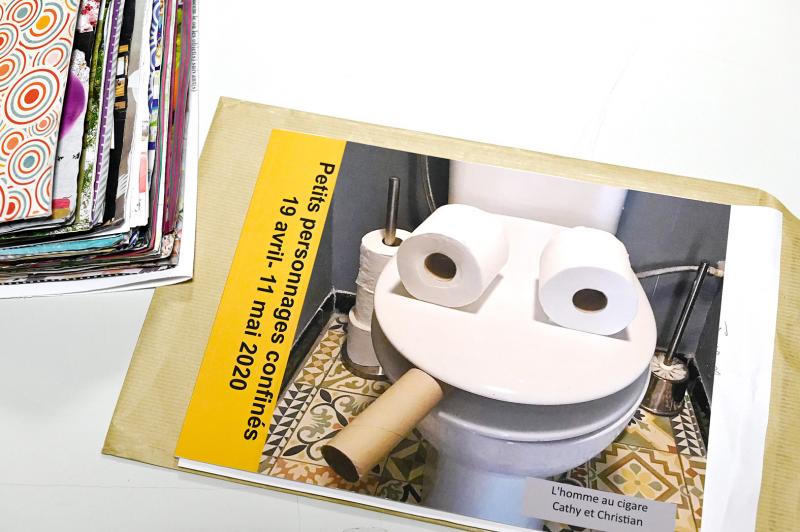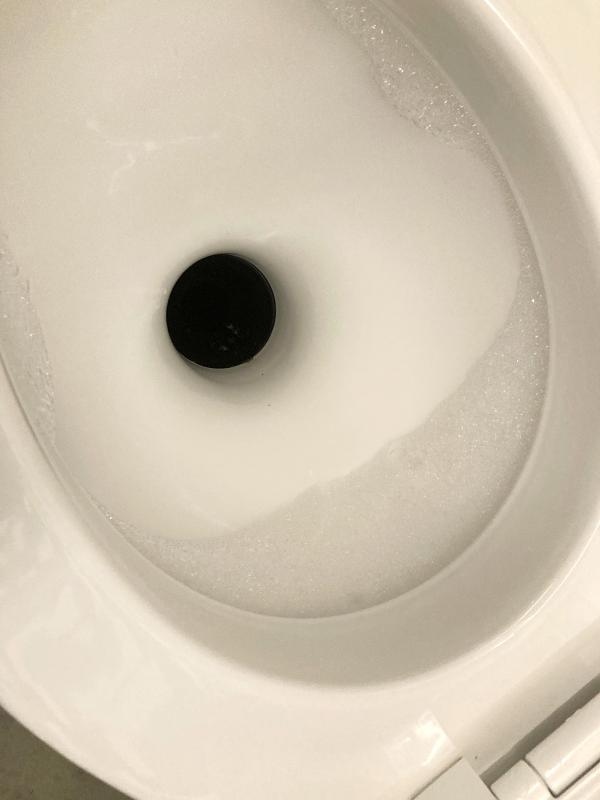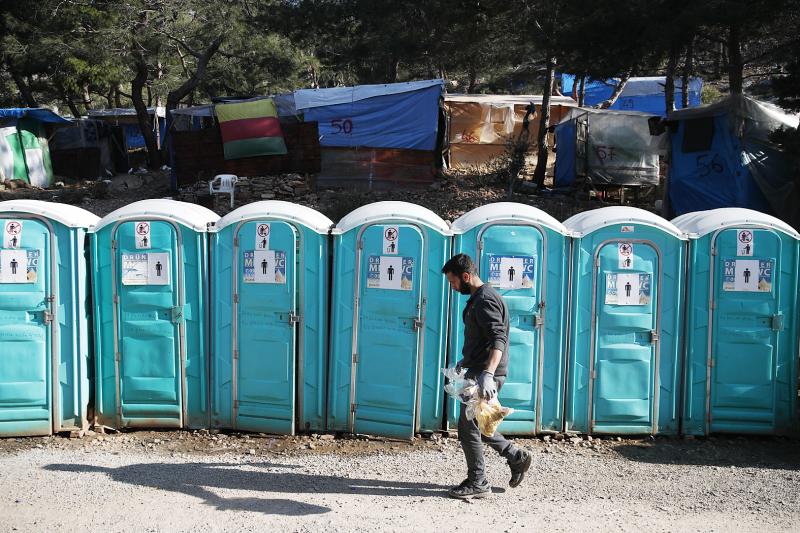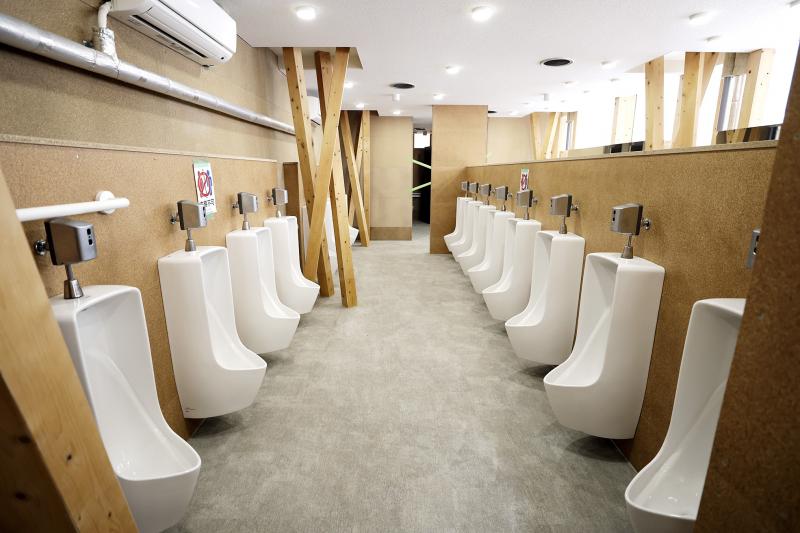For the past 10 years, Sonia Grego has been thinking about toilets — and more specifically what we deposit into them.
“We are laser-focused on the analysis of stool,” says the Duke University research professor, with all the unselfconsciousness of someone used to talking about bodily functions. “We think there is an incredible untapped opportunity for health data. And this information is not tapped because of the universal aversion to having anything to do with your stool.”
As the co-founder of Coprata, Grego is working on a toilet that uses sensors and artificial intelligence to analyze waste; she hopes to have an early model for a pilot study ready within nine months.

Photo: AFP
“The toilet that you have in your home has not functionally changed in its design since it was first introduced,” she says, in the second half of the 19th century. There are, of course, now loos with genital-washing capabilities, or heated seats, but this is basic compared with what Grego is envisaging. “All other aspects of your life — your electricity, your communication, even your doorbell — have enhanced capabilities.”
‘HEALTHY BASELINE’
The smart toilet’s time has come and it is a potentially huge market — in the developed world, everyone who is able to uses a toilet multiple times a day. Grego adds that she can “certainly envision a world” in which a toilet that does more than flush excreta “is available to every household”.

Photo: AP
There are numerous companies working on bringing that to market — a race to the bottom, if you will.
Smart toilet innovators believe the loo could become the ultimate health monitoring tool. Grego believes her product — which analyzes and tracks stool samples and sends the data to an app — will provide “information related to cancer and many chronic diseases.”
For general consumers, it will provide peace of mind, she says, by establishing “a healthy baseline:” “Having technology that tracks what is normal for an individual could provide an early warning that a checkup is needed.”

Photo: AP
For people with specific conditions, such as inflammatory bowel disease, the device could provide helpful monitoring for doctors.
“It’s very difficult to know when to escalate or de-escalate treatment,” she says. “Stool-based biomarkers can provide that information.”
At some point, she thinks, a smart toilet could make lifestyle suggestions — it could tell you to eat more fiber or certain nutrients, for instance, or work out what kind of food triggered an uncomfortable gastric episode.

Photo: Bloomberg
“The science of nutrition is really moving in the direction of personalized nutrition,” says Grego. “Our technology will be an enabler of this, because you have information of what you eat, but we can make seamless the obtaining of information of what comes out.”
TOILET TECHNOLOGY
The toilet technology being developed by Joshua Coon’s academic lab is focused on urine, because it is easier to sample and analyze. He describes himself as “a smart toilet enthusiast,” rather than someone who is racing to get a product to market, although he says he is in talks with industry leaders.
“There are several thousand known different small molecules that exist in urine and they give you insight into what’s going on,” says Coon, who is a professor of chemistry and biochemistry at the University of Wisconsin-Madison.
In a small study he conducted, two people — one of whom was Coon — saved every urine sample for 10 days.
“It turns out that you can detect compounds that are diagnostic of exercise [show you have done some]; you can see when an over-the-counter medication comes into the system and clears out; you can see molecules that correlate with how well you slept, how much fat you had in your diet, what your calorie intake was.”
The study wasn’t set up to look at long-term health, he says, but the implications are there.
“Combining that with health records and lifestyle data, a lot of these molecules almost certainly could correlate with important disease risk and be able to much better predict a person’s need for intervention. That’s the vision, if one had the technical capability to make these measurements in a toilet.”
Similar developments have been made elsewhere. In 2018, Panasonic launched a smart toilet in China that tested urine and tracked body fat. This year, at the influential annual Consumer Electronics Show, the Japanese manufacturer Toto announced its “wellness toilet” — a concept, but something it is working on (it previously developed a toilet that analyzes urine flow). Its sensors — including one for scent — would aim to detect health problems and conditions such as stress, but also make lifestyle suggestions. In one image provided by the company, it envisioned the toilet sending you a recipe for salmon and avocado salad.
ANALYZING POOP
Researchers at the Stanford School of Medicine have been working on technology that can analyze faeces (including “stool dropping time”) and track the velocity and color of urine, as well as test it. An article this month in the Wall Street Journal reported that the researchers have partnered with Izen, a Korean toilet manufacturer, and hope to have prototypes by the end of the year. In order to differentiate between users, Izen developed a scanner that can recognize the physical characteristics of whoever is sitting on the toilet — or, in the words of the researchers, “the distinctive features of their anoderm” (the skin of the anal canal). Apparently, your “analprint,” like your fingerprints, is unique.
Vik Kashyap says we are ready for it (well, perhaps not scanners — in Stanford’s study of user acceptance, “the least favored module is analprint”).
Kashyap’s company, Toi Labs, has been working in the smart toilet space for about two decades and has a longstanding interest in gut health (he successfully treated his own ulcerative colitis by ingesting parasitic worms). He has seen other companies’ attempts at the smart toilet fail, but he thinks now may be the time. Not only has it become normal to track our data through wearables such as an Apple Watch or a Fitbit, but we are also less squeamish. Kashyap puts this down to the surge of interest and research in the microbiome and our gut health , including poo, which “has made this topic less of a taboo.”
He also thinks the pandemic has accelerated matters — the run on loo roll highlighted the fact that people panicked about how they were going to wipe their bottoms, while laboratories have been testing sewage to track the virus.
“And then, finally, the cost of delivering sensor-based Internet of Things systems at home has come down considerably. Products like Alexa are well established and people are beginning to realize that their home is going to evolve over time.”
Kashyap has developed a toilet seat, TrueLoo, which can be fixed to an existing toilet and recognizes the user by their phone (one survey found that a majority of Britons take their phone to the loo ) or a combination of physiological parameters: “What do they weigh? How are they sitting on the seat?” It then analyzes excreta “using optical methods, looking at things like the volume, clarity, consistency, color. It’s essentially understanding when someone has abnormal patterns and then it’s capable of documenting those patterns and providing reports that can be used by physicians to help in the treatment of a variety of conditions.”
For now, TrueLoo is focused on the older adult market — people more at risk of genitourinary and gastrointestinal problems, such as those in residential care homes — but, Kashyap says, “we very much have an eye towards this being a consumer product that is going to be used by anyone who has a toilet.”
When Kashyap started thinking about analyzing waste, he thought he should go down the biochemistry route.
“But I learned over the years there’s a lot of amazing technology in the visual analysis realm,” he says. It also comes at a much lower cost.
“People think: ‘We’ll put all these very complicated sensors into a toilet, we’ll do chemical analysis.’ When you start doing that, you start increasing the cost. You can’t tell someone: ‘I’m going to replace your US$20 toilet seat with a US$2,000 toilet seat, or a US$12,000 toilet,’ that’s not really viable.”
Kashyap predicts (although he admits he is biased) that some version of the smart toilet “is going to be the most important home medical product in the future. There’s a limit to what can be done with
wearables, but the toilet is going to be a far deeper way to understand a person’s health.”
ANALPRINT PRIVACY CONCERNS
Is all this — your analprint out in the world, the makeup of your bowel movements analysed — a privacy breach too far?
“Can it be kept secure?” asks Eerke Boiten, a professor of cybersecurity at De Montfort University in Leicester. “What sort of organization has this data? Who will they be sharing data with? What data will it get combined with? Will we have any transparency about where the data goes? This is an area where we don’t even know fully what the risks are. We need significant research into this.”
Many people “wouldn’t, for very good reasons, like cameras pointing up their bottoms,” says Phil Booth, the coordinator of MedConfidential, which campaigns for the confidentiality of medical records. That said, under the guidance of a medical professional, “there are not necessarily inherent privacy risks” in using a smart toilet as a medical device, he says. However, it might get interesting
if the data created by general consumer use was owned by a company: “You may trust that particular company, but every company is pretty much buyable by Google or Facebook or Amazon. Then, what I thought was something for my own health monitoring has become fodder to business models I really know nothing about.”
People bought Fitbits, says Booth, “thinking it was just a cool new item to monitor their exercise and, hey presto, Google buys it. All of a sudden, all that really rich data gets absorbed into a company that has other agendas.”
Google has had its eye on the multitrillion-dollar health market, with an attempt to become dominant in health data, for some time — controversially, it has had access to the health data of and 50 million Americans. Is Google interested in your bathroom habits? Well, it patented a toilet seat sensor way back in 2016.
When it comes to information about your bodily waste, Booth says: “What data are companies linking together? What are they trying to analyze about you? Profile you for? You call them ‘smart homes,’ but they’re surveillance homes.”
Information from stool and urine samples could provide all sorts of information — your risk of disease, your diet, your exercise level; how much alcohol you drink and whether you take drugs. Even tracking something as trivial as the time of day you use the loo — regularly in the night, for instance, indicating sleeplessness — could reveal conditions such as depression or anxiety.
Where does it end? Could the police or others involved in surveillance track you by analprint, via the public and home smart lavatories you visit? Might you be asked to provide a print at a police station?
Imagine a world where smart toilets in workplaces were able to tell which employees were pregnant, or taking drugs, or at risk of physical or mental ill-health, with the implication that they were potentially not as productive, or about to be absent from work.
“Think about Texas,” says Booth of that state’s recently tightened abortion restrictions. “If you can tell if someone’s pregnant from their poo, then all of a sudden the question is: ‘Are they seeking an abortion?’ That’s Gilead level, that’s science fiction, but it illustrates the risk.”
It is not so wacky to imagine parents using the technology to check whether their teenage children are using drugs.
“Once you start to measure something that is of the body, the privacy line is stepped over,” says Booth. “If you don’t measure what’s going on with someone’s bowel movements, the bowel movement is private.”
This is an alarming thought — but, says Booth with a laugh, it is not as though governments will mandate smart toilets. He says there will always be people — those into the “quantified self” movement — who are happy to measure and track themselves. If smart loos are considered clinical devices collecting medical data, “then it’s a straight medical breach risk — not special to toilets, but because you’ve turned the toilet into a medical data-generating experience.
Are they managing those risks correctly?”
Coon is also mindful of the issues.
“Do insurance companies get to know what’s in your urine? You can imagine those hurdles, but if the technology exists, and there’s benefit, people will figure out how to solve it.” Kashyap says: “The way I look at it, this is basically part of your medical record. This would probably fall in the same category of risk — and, at least in the US, there is a lot of protection around medical records.”
Will the smart toilet become a normal bathroom fixture? This question is applicable only in the developed world. If you want to talk toilet inequality, 3.6 billion people — nearly half the world’s population — have no access to safe sanitation, let alone a loo that can track sleep quality and fiber intake. But those working on smart toilets are optimistic.
“It’s about figuring out how to get the technology we have in the laboratory into a toilet at a scale that’s affordable and robust,” says Coon. “That’s the challenge. It could be 10 years out, or 30 years out, but I think it’s something that’s going to happen.”

March 24 to March 30 When Yang Bing-yi (楊秉彝) needed a name for his new cooking oil shop in 1958, he first thought of honoring his previous employer, Heng Tai Fung (恆泰豐). The owner, Wang Yi-fu (王伊夫), had taken care of him over the previous 10 years, shortly after the native of Shanxi Province arrived in Taiwan in 1948 as a penniless 21 year old. His oil supplier was called Din Mei (鼎美), so he simply combined the names. Over the next decade, Yang and his wife Lai Pen-mei (賴盆妹) built up a booming business delivering oil to shops and

The Taipei Times last week reported that the Control Yuan said it had been “left with no choice” but to ask the Constitutional Court to rule on the constitutionality of the central government budget, which left it without a budget. Lost in the outrage over the cuts to defense and to the Constitutional Court were the cuts to the Control Yuan, whose operating budget was slashed by 96 percent. It is unable even to pay its utility bills, and in the press conference it convened on the issue, said that its department directors were paying out of pocket for gasoline

On March 13 President William Lai (賴清德) gave a national security speech noting the 20th year since the passing of China’s Anti-Secession Law (反分裂國家法) in March 2005 that laid the legal groundwork for an invasion of Taiwan. That law, and other subsequent ones, are merely political theater created by the Chinese Communist Party (CCP) to have something to point to so they can claim “we have to do it, it is the law.” The president’s speech was somber and said: “By its actions, China already satisfies the definition of a ‘foreign hostile force’ as provided in the Anti-Infiltration Act, which unlike

Mirror mirror on the wall, what’s the fairest Disney live-action remake of them all? Wait, mirror. Hold on a second. Maybe choosing from the likes of Alice in Wonderland (2010), Mulan (2020) and The Lion King (2019) isn’t such a good idea. Mirror, on second thought, what’s on Netflix? Even the most devoted fans would have to acknowledge that these have not been the most illustrious illustrations of Disney magic. At their best (Pete’s Dragon? Cinderella?) they breathe life into old classics that could use a little updating. At their worst, well, blue Will Smith. Given the rapacious rate of remakes in modern